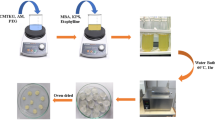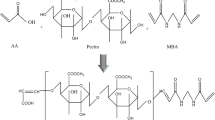Abstract
In the current study, the synthesis of hydrogel based on carboxymethyl tamarind kernel gum (CMTKG), poly(sodium acrylate) (PSA), xanthan gum (XG) and its loading with metformin hydrochloride (metformin HCl) was successfully carried out and characterized using various techniques. Furthermore, the optimization of hydrogel was done by varying the amount of carboxyl methyl tamarind kernel gum (CMTKG), N, N′-methylene-bis-acrylamide (MBA) or potassium persulphate (KPS), and their influence on the swelling ratio was examined. The fabricated hydrogels were characterized by attenuated total reflection-Fourier transform infrared spectroscopy (ATR-FTIR), powder X-ray diffraction (PXRD) and scanning electron microscopy (SEM), whereas thermal stability was confirmed by thermogravimetry analysis (TGA). The hydrogels’ swelling ratio and in vitro drug release studies were assessed in pH 1.2 and 7.4 buffer solutions and showed better results in alkaline pH. The drug release profile of metformin-loaded CMTKG/PSA/XG hydrogel obeyed the Korsmeyer–Peppas model and follow non-Fickian diffusion in pH 7.4 and Fickian diffusion mechanism at pH 1.2. This pH-dependent behaviour of the metformin HCl-loaded CMTKG/PSA/XG hydrogel could be applicable for site-specific release of metformin HCl.










Similar content being viewed by others
Data availability
The datasets generated during and/or analyzed during the current study are available from the corresponding author on reasonable request.
References
Madduma-Bandarage USK, Madihally SV (2021) Synthetic hydrogels: synthesis, novel trends, and applications. J Appl Polym Sci 138:1–23. https://doi.org/10.1002/app.50376
Ahmed EM (2015) Hydrogel: preparation, characterization, and applications: a review. J Adv Res 6:105–121. https://doi.org/10.1016/j.jare.2013.07.006
Rizwan M, Rubina Gilani S, Iqbal Durani A, Naseem S (2021) Materials diversity of hydrogel: synthesis, polymerization process and soil conditioning properties in agricultural field. J Adv Res 33:15–40. https://doi.org/10.1016/j.jare.2021.03.007
Sabbagh F et al (2019) Strategies in improving properties of cellulose-based hydrogels for smart applications. Springer, 887–908. https://doi.org/10.1007/978-3-319-77830-3_30
Sharpe LA, Daily AM, Horava SD, Peppas NA (2014) Therapeutic applications of hydrogels in oral drug delivery. Expert Opin Drug Deliv 11:901–915. https://doi.org/10.1517/17425247.2014.902047
Liu L, Yao W, Rao Y, Lu X, Gao J (2017) pH-Responsive carriers for oral drug delivery: challenges and opportunities of current platforms. Drug Deliv 24:569–581. https://doi.org/10.1080/10717544.2017.1279238
Al-nasra M (2013) Optimizing the use of sodium polyacrylate in plain concrete. Int J Eng Res Appl 3:1058–1062
Sennakesavan G et al (2020) Acrylic acid/acrylamide based hydrogels and its properties - a review. Polym Degrad Stab 180:109308. https://doi.org/10.1016/j.polymdegradstab.2020.109308
Singh AV (2011) Biopolymers in drug delivery: a review. Pharmacologyonline 1:666–674
Malviya R et al (2021) Evaluation and characterization of tamarind gum polysaccharide: the biopolymer. Polymers (Basel) 13:1–18. https://doi.org/10.3390/polym13183023
Khushbu, Warkar SG (2022) Carboxymethyl tamarind kernel gum based controlled drug delivery excipients: a review. J Eng Res (Kuwait) 10:27–40. https://doi.org/10.36909/jer.ICAPIE.15061
Kaur G, Jain S, Tiwary AK (2010) Chitosan-carboxymethyl tamarind kernel powder interpolymer complexation: investigations for colon drug delivery. Sci Pharm 78:57–78. https://doi.org/10.3797/scipharm.0908-10
Khushbu, Warkar SG (2020) Potential applications and various aspects of polyfunctional macromolecule- carboxymethyl tamarind kernel gum. Eur Polym J 140:110042. https://doi.org/10.1016/j.eurpolymj.2020.110042
Petri DFS (2015) Xanthan gum: a versatile biopolymer for biomedical and technological applications. J Appl Polym Sci 132. https://doi.org/10.1002/app.42035
Deshpande AD, Harris-Hayes M, Schootman M (2008) Epidemiology of diabetes and diabetes-related complications. Phys Ther 88:1254–1264. https://doi.org/10.2522/ptj.20080020
Cheng AYY, Fantus IG (2005) Oral antihyperglycemic therapy for type 2 diabetes mellitus. Can Med Assoc J 172:213–226. https://doi.org/10.1503/cmaj.1031414
Barleany DR, Ananta CV, Maulina F, Rochmat A, Alwan H, Erizal (2020) Controlled release of metformin hydrogen chloride from stimuli-responsive hydrogel based on poly(N-Isopropylacrylamide)/Chitosan/Polyvinyl alcohol composite. Int J Technol 11:511–521. https://doi.org/10.14716/ijtech.v11i3.2330
Wei QB, Fu F, Zhang YQ, Wang Q, Ren YX (2014) PH-responsive CMC/PAM/PVP semi-IPN hydrogels for theophylline drug release. J Polym Res 21. https://doi.org/10.1007/s10965-014-0453-0
Khushbu SG, Warkar, Thombare N (2022) Controlled release and release kinetics studies of boron through the functional formulation of carboxymethyl tamarind kernel gum-based superabsorbent hydrogel. Polym Bull 79:2287–2303. https://doi.org/10.1007/s00289-021-03634-9
Niu B et al (2019) In vitro and in vivo release of diclofenac sodium-loaded sodium alginate/carboxymethyl chitosan-ZnO hydrogel beads. Int J Biol Macromol 141:1191–1198. https://doi.org/10.1016/j.ijbiomac.2019.09.059
Sun S et al (2023) Drug delivery systems based on polyethylene glycol hydrogels for enhanced bone regeneration. Front Bioeng Biotechnol 11:1–17. https://doi.org/10.3389/fbioe.2023.1117647
Tan LS et al (2021) Fabrication of radiation cross-linked diclofenac sodium loaded carboxymethyl sago pulp/chitosan hydrogel for enteric and sustained drug delivery. Carbohydr Polym Technol Appl 2:100084. https://doi.org/10.1016/j.carpta.2021.100084
Sabbagh F et al (2023) Ex vivo transdermal delivery of nicotinamide mononucleotide using polyvinyl alcohol microneedles. Polymers 15:2031. https://doi.org/10.3390/polym15092031
Jana S, Sharma R, Maiti S, Sen KK (2016) Interpenetrating hydrogels of O-carboxymethyl tamarind gum and alginate for monitoring delivery of acyclovir. Int J Biol Macromol 92:1034–1039. https://doi.org/10.1016/j.ijbiomac.2016.08.017
Varahala Setti ML, Ratna JV (2009) Preparation and evaluation of controlled release tablets of carvedilol. Asian J Pharm 3:252–256. https://doi.org/10.4103/0973-8398.56307
Sabbagh F, Muhamad II (2017) Acrylamide-based hydrogel drug delivery systems: release of acyclovir from MgO nanocomposite hydrogel. J Taiwan Inst Chem Eng 72:182–193. https://doi.org/10.1016/j.jtice.2016.11.032
Mali KK, Dhawale SC, Dias RJ (2017) Synthesis and characterization of hydrogel films of carboxymethyl tamarind gum using citric acid. Int J Biol Macromol 105:463–470. https://doi.org/10.1016/j.ijbiomac.2017.07.058
Khushbu, Warkar SG, Kumar A (2019) Synthesis and assessment of carboxymethyl tamarind kernel gum based novel superabsorbent hydrogels for agricultural applications. Polymer 182:121823. https://doi.org/10.1016/j.polymer.2019.121823
Jagdale SC, Patil SA, Kuchekar BS, Chabukswar AR (2011) Preparation and characterization of metformin hydrochloride-compritol 888 ATO solid dispersion. J Young Pharm 3:197–204. https://doi.org/10.4103/0975-1483.83758
Rashid H et al (2015) Synthesis and characterization of poly(hydroxyethyl methacrylate-co-methacrylic acid) cross linked polymeric network for the delivery of analgesic agent. J Chem Soc Pak 37:99–1007
Malik R, Warkar SG, Saxena R (2023) Carboxy-methyl tamarind kernel gum based bio-hydrogel for sustainable agronomy. Mater Today Commun 35:105473. https://doi.org/10.1016/j.mtcomm.2023.105473
Roy H, Brahma C, Nandi S, Parida K (2013) Formulation and design of sustained release matrix tablets of metformin hydrochloride: influence of hypromellose and polyacrylate polymers. Int J Appl Basic Med Res 3:55. https://doi.org/10.4103/2229-516x.112242
Shoukat H, Pervaiz F, Noreen S, Nawaz M, Qaiser R, Anwar M (2020) Fabrication and evaluation studies of novel polyvinylpyrrolidone and 2-acrylamido-2-methylpropane sulphonic acid-based crosslinked matrices for controlled release of acyclovir. Polym Bull 77:1869–1891. https://doi.org/10.1007/s00289-019-02837-5
Goonoo N, Bhaw-Luximon A, Ujoodha R, Jhugroo A, Hulse GK, Jhurry D (2014) Naltrexone: a review of existing sustained drug delivery systems and emerging nano-based systems. J Control Release 183:154–166. https://doi.org/10.1016/j.jconrel.2014.03.046
Das D, Das R, Mandal J, Ghosh A, Pal S (2014) Dextrin crosslinked with poly(lactic acid): a novel hydrogel for controlled drug release application. J Appl Polym Sci 131:1–12. https://doi.org/10.1002/app.40039
Acknowledgements
The authors are eternally grateful to the Delhi Technological University, New Delhi, India, for its infrastructure.
Author information
Authors and Affiliations
Contributions
Conceptualization: Sudhir G. Warkar, Priyanka Meena; methodology: Tushar, Yash Saraswat; formal analysis and investigation: Tushar, Yash Saraswat; writing—original draft preparation: Tushar, Yash Saraswat; writing—review and editing: Sudhir G. Warkar, Priyanka Meena; funding acquisition: NA; resources: Tushar, Yash Saraswat; supervision: Sudhir G. Warkar.
Corresponding authors
Ethics declarations
Ethical approval
Not applicable.
Competing interests
The authors declare no competing interests.
Additional information
Publisher's Note
Springer Nature remains neutral with regard to jurisdictional claims in published maps and institutional affiliations.
Rights and permissions
Springer Nature or its licensor (e.g. a society or other partner) holds exclusive rights to this article under a publishing agreement with the author(s) or other rightsholder(s); author self-archiving of the accepted manuscript version of this article is solely governed by the terms of such publishing agreement and applicable law.
About this article
Cite this article
Tushar, Saraswat, Y., Meena, P. et al. Synthesis and characterization of novel xanthan gum-based pH-sensitive hydrogel for metformin hydrochloride release. Colloid Polym Sci 301, 1147–1158 (2023). https://doi.org/10.1007/s00396-023-05135-9
Received:
Revised:
Accepted:
Published:
Issue Date:
DOI: https://doi.org/10.1007/s00396-023-05135-9




